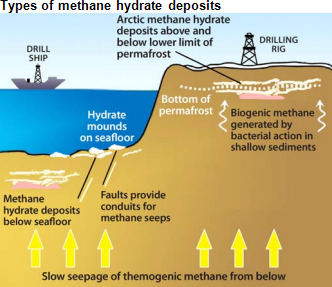Another “Game-changer”

Methane hydrate is a newly discovered source of natural gas. It lies deep under sea beds and within permafrost. The U.S. Department of Energy describes it as a “cage-like lattice of ice” that is trapped by methane molecules. The “fire ice,” as it is also referred to, is formed in the sweet-spot of low temps and high pressure of continental shelves, which creates the icy state. Little is known about this substance, except that there is a lot of it. Countries all over the world are looking into the resource that has the potential to sustain energy needs for the next 1,000 years.
Unstable source
When methane hydrate is removed from its environment, it becomes unstable. Methane escapes, melting the ice, when pressure or heat is removed. This makes the substance difficult to study.
Hydrate deposits are found in Arctic permafrost or beneath the ocean floor and can be found in both biogenic and thermogenic forms. There are four environments it thrives in: 1) sedimentary rock below Arctic permafrost that formed when dinosaurs roamed the Earth; 2) sediment along continental margins; 3) deep-water sediments of major inland water sources, such as lakes and seas; 4) and under Antarctic ice (King). Though not including the latter, usually methane deposits are within a few hundred meters of the surface. These dense ice forms in layers and nodules that trap natural gas moving from deep within the Earth.
Methane hydrate hasn’t reached commercial production, as it is still in the experimental and small-scale phases. A map by the U.S. Geological Survey shows that deposits mostly line the continents of the world, with some inland in Canada, China, and Russia.
Early exploration has located enormous amounts of methane hydrate all over the world. There is hope within the energy sector that, because deposits are closer to populated areas, countries may become more reliant on hydrate methane versus natural gas out of convenience and desire to be energy self-sufficient.
The future of energy?
When either heated or depressurized, one cubic meter of methane hydrate releases 164 cubic meters of natural gas. This is a number that excited the energy world. Because it’s still in the developing stages and far from commercialization, the material is being researched by many different groups, individuals, and countries. The Gas Hydrates R&D Program within the Department of Energy’s Fossil Fuel sector seeks to develop technology and methods to harness and produce energy from methane hydrate. Also, China and Japan were the first to deploy researchers to extract the resource. They found thousands of cubic meters in 2017.
In 2018, U.S. Geological Survey, dedicated to exploration and research, concluded that the overall available methane hydrate is approximately 20,000 trillion cubic meters in reserves. This massive find has — though perhaps prematurely — been called a solution to meet energy needs for the next several decades. Because it releases an enormous amount of energy within small amounts of the material, it’s looked at as cost-efficient and a solution to longlasting dependency on fossil fuels.
The future is still unknown, however, countries are extending the effort to find out the viability of the methane hydrate reservoirs.
Sources
Hobart M. King Ph. D. “Methane Hydrate: The world’s largest natural gas resource is trapped beneath permafrost and ocean sediments” Geology.com
Richard Anderson (2014). “Methane hydrate: Dirty fuel or energy savior?” BBC
Interview with Carolyn Ruppel, chief of USGS Gas Hydrates Project (2019). Yale Climate Connections
ReportLinker (2019). “The methane hydrate extraction market is projected to reach 66,901.8 thousand cubic meter by 2025, growing at a CAGR of 6.3% from 2021 to 2025” Cision PR Newswire




